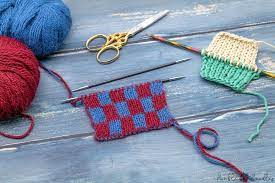How to Double Knit
Jump To:

Learning double knitting is simple. You can create beautiful projects, and keep yourself cozy with this one-of-a-kind technique! Double knit by using two contrasting colors or the same color to make your finished product unique and interesting. With just a few steps you’ll learn how to double knit in no time! The yarn used to double knit is also important here’s more about double knit yarn.
What is Double Knitting
The double knitting technique utilizes two layers of fabric to increase the thickness and warmth. This makes it perfect for socks in winter or oven mitts with protective features.
Double knitting can be a slow process, but the results are worth it. This technique makes beautiful reversible projects that add an extra pop of color to your pieces!
Double Knitting Tips
Double knitting has two layers, so you will need twice as many stitches as normal.
Figuring out how many stitches to cast on is often a point of confusion for beginners who are new to double knitting. Many patterns leave this detail out which can confuse knitters looking at the pattern later down the line or when they want to make more hats in different sizes using their favorite stitch pattern.
All one needs to do is count the number of stitches found within each row and multiply it by two – that’s all! This way, no matter whether your hat comes from an adult medium size head or child small sized-head; there will be enough room without restricting any movement whatsoever with excess fabric (and wasting yarn).
Double your stitch count in the pattern and that’s the number of stitches you should hold when starting double-knitting!
How to Cast On
One of the easiest methods to start with is learning a long-tail cast on. It’s easy and fast so it’s perfect for beginners.
Flat or in the Round?
Double knitting can either be flat or in the round. Double-knitting is easier if you are a beginner, so we recommend this method for those who have never done it before.
How Do I Read a Chart?
Each square of a chart is one knit stitch on the front and a purl stitch on the back. A chart shows only one side and you will not see the back because it is the same. Watch the video below for more information on how to read double knitting charts.
Selvage Stitches
Selvage stitches are the most popular for creating a nice edge when double knitting. As you will have selvage stitches at each end, it provides an optimal closed edge where your fabric joins as well.
Working Your Pattern
Stockinette stitch when double knitting the sides of your fabric.
To get started double knitting, you will need to first keep in mind the basics of k1, p1 stitches. For every knit stitch that you make, don’t break your rhythm by moving only one yarn! Also before any purl stitch is made be sure both yarns are at the front or back of work depending on which type of stitch it’s going to create.
While knitting you create yarn layers on both the front and back of your fabric. Each stitch produces its own specific layer, which you can see from either side depending on whether or not it’s knit (front) or purled (back).
How To Bind Off
To cast on using two yarn colors, hold both pieces together as one piece and knit the first two stitches. Then bind off a stitch (do this by lifting the loop from the row below with your left needle) but use only one strand since you are working in pairs now – knit another stitch, purl another.
Repeat the process until you have two stitches left, and then knit them together.
